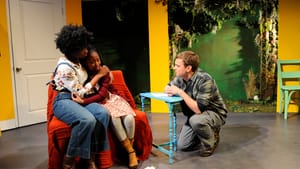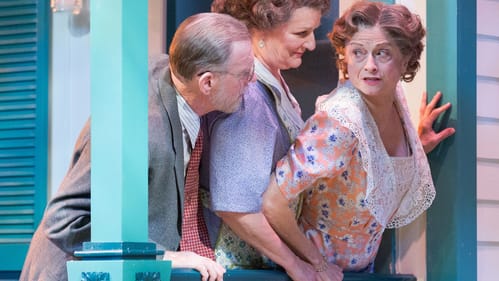Stay in the Loop
BSR publishes on a weekly schedule, with an email newsletter every Wednesday and Thursday morning. There’s no paywall, and subscribing is always free.
2018: The year of the revival
Cameron Kelsall’s best Philadelphia-area theater of 2018

Last December, I did something I swore I never would: I wrote an end-of-year best list. I didn’t intend to make it a tradition.
And then people started asking me when my 2018 list would appear. Initially I begged off, believing — as I still do — that this oversimplifies the breadth and scope of our local theater scene. I saw 235 productions in 2018. Far more deserve praise than I can squeeze into a single column.
But the thought of recognizing a handful of truly outstanding work stuck in my mind, and as my pen hit the paper, a theme emerged. I dubbed 2017 “the year of the breakout Philly playwright.” But 2018 was the year of the revival.
Standout new work
This isn’t to say that I didn’t see any worthy new work on local stages. I would rank James Ijames’s stunning, urgent Kill Move Paradise among the best plays I’ve seen on any stage in the country over the past half-decade or so. The folks who administer the prestigious Kesselring Prize clearly agree — they distinguished Ijames with their annual award, which comes with a $25,000 honorarium.
Christopher Durang’s blistering Turning Off the Morning News erupted with rage and humor in its world premiere at McCarter Theatre Center in Princeton, New Jersey. And as part of the Philadelphia Fringe Festival, local scribe Douglas Williams offered a tender take on the origin story of indie rock’s great tortured bard with Bon Iver Fights a Bear.
Living classics, defined
But the work that most excited and surprised me throughout the year came from authors long established… or long dead. Philly theater companies excelled at bringing out the contemporary relevance lodged within the classics.
Take, for example, Quintessence Theatre Group’s (QTG) haunting production of The Wild Duck. Director Rebecca Wright and her ensemble devised an adaptation of Ibsen’s 1884 play that respected the original work while connecting it to contemporary issues, including economic instability, political myopia, and the #MeToo movement. The production, which won a Barrymore Award for Maria Shaplin’s memorable lighting design, served as the very definition of a living classic.
QTG also presented a revival of Beckett’s Waiting for Godot that made me look at a play I’ve seen at least a dozen times — and, frankly, thought I never needed to see again — with renewed vigor. As the peripatetic tramps Estragon and Vladimir, Frank X and Johnnie Hobbs Jr. supplied the layers of lived-in friendship, kinship, and exasperation that are often missing from productions of this play. Moments that have become iconic to the point of parody, like Estragon’s inability to remove his shoe, pulsed with a newfound sense of immediacy.
Anguish and humor
I have come to expect reinvention from the scrappy, gloriously named Idiopathic Ridiculopathy Consortium, which specializes in absurdist theater. Sometimes it works, sometimes it doesn’t. But nothing prepared me for the revelation of director/actor Tina Brock’s The Eccentricities of a Nightingale, presented as part of the Fringe Festival at the Bethany Mission Gallery, a private temple to outsider art.

Tennessee Williams sometimes wrote with an operatic fervor that verges on the absurd and can seem grotesque in the wrong hands. Brock treated this late-career reworking of Summer and Smoke with subtlety and pathos, allowing the humor and the anguish embedded in the play to flow naturally. As an actor, Brock made a wonderful impression as Alma Winemiller — less a flighty loner and more a woman misunderstood by a society she cannot escape. As her object of desire, John Zak — a performer justly vaunted for comedic skill — showed himself equally deft at drama.
Excellence at PAC
The fascinating resonance of an odd venue bolstered another Philly Fringe find: J.M. Barrie’s rarely staged ghost story Mary Rose, which Philadelphia Artists’ Collective (PAC) presented at the Woodlands Mansion and Cemetery in West Philly. Barrie’s play follows a young woman who mysteriously vanishes and reappears at different points in her life, never seeming to age or show awareness of her absence. The ghostly calm of the lush, well-maintained cemetery — which served as the al-fresco setting for the play’s second act — heightened the work’s paranormal elements.
In a more traditional setting, PAC scored a triumph of a different kind with Maria Marten, or, The Murder in the Red Barn, an honest-to-goodness 19th-century melodrama. The company leaned into the hokier elements of the genre — constant live piano underscoring, music-hall acting, and delightfully shabby sets — and showed a level of comfort with this very particular material rarely seen in a contemporary troupe. Company cofounders Damon Bonetti and Dan Hodge alternated performances as the villain and the dullard with equal alacrity. And in the title role, Victoria Aaliyah Goins was luminous.

Seeing ourselves
The production that stayed with me most all year came early in 2018: People’s Light & Theatre Company’s (PLTC) revival of Paul Osborn’s Morning’s at Seven, a surprisingly durable family dramedy from 1939. It proved a perfect work for PLTC’s long-standing resident acting company — which constitutes a family in its own right. (The cast members won a richly deserved Barrymore for Outstanding Ensemble; the production also took top honors for Outstanding Production of a Play).
The audience at the performance I attended on a chilly February night included many generations, including millennials like me whose parents weren’t even born when this play premiered. But despite our many differences, the audience laughed, nodded in recognition, and saw ourselves. My husband, an often reluctant theatergoer, fought back tears.
These revivals don’t replace the need for new and more diverse voices in the theater. But they do show that works of previous generations still have a lot to say. And with the exception of the ubiquitous Godot, none of these plays are repertory staples. Perhaps that’s a lesson, too: When theater companies decide to stage existing works, remember that the real gems may lie outside the accepted canon.
Sign up for our newsletter
All of the week's new articles, all in one place. Sign up for the free weekly BSR newsletters, and don't miss a conversation.

 Cameron Kelsall
Cameron Kelsall